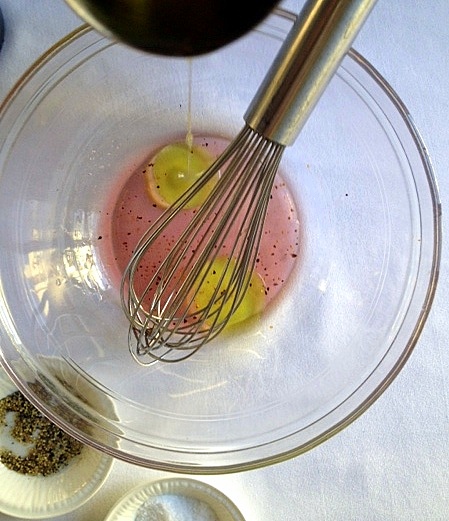“The usual proportion of vinegar to oil is one to three, but you should establish your own relationship.”
Julia Child, Mastering the Art of French Cooking
“This is the sauce I make most often, and if it’s made of out of good olive oil and good wine vinegar, it’s the best salad dressing I can imagine.”
Alice Waters, The Art of Simple Food
Vinaigrette 101
Vinaigrette is one of the simplest sauces to make at home and offers an instant upgrade to any salad green or vegetable. Most of us have used bottled salad dressing at one time or another simply out of convenience, but the truth is there is no healthier way to dress your veggies (and fruits!) than a simple sauce made from extra virgin olive oil and quality vinegar. It’s quick to come together and keeps well in the fridge, so you can use it throughout the week. Add to that the heart healthy benefits of extra virgin olive oil and the elimination of something produced in a factory from your diet, and there is no excuse for not making your own vinaigrette. We’ll start with a simple formula for making vinaigrette that can be modified in thousands of ways to create unique combinations of flavor and texture. Let’s begin!
First, know the ratio. A vinaigrette is typically made from 1 part vinegar to 3 or 4 parts oil. If you’re using a standard wine vinegar or lemon juice, or one of We Olive’s more tart champagne vinegars, this is a good ratio to use. If you are using a sweeter vinegar, like an aged balsamic or a fruity vinegar with more sweetness, you make want to increase the ratio to 1 part vinegar to 2 parts oil. The oil acts to balance out the acidity of the vinegar, so an acidic or tart vinegar will require more oil. A sweeter vinegar, like aged balsamic, has a more mellow acidity, requiring less oil for balance. You can also choose to experiment with a combination of citrus juices and vinegars.
Second, whisk (or blend) well. For a vinaigrette to literally come together, it has to be properly mixed into an emulsion. If the oil and vinegar aren’t emulsified, they will stay separate creating bites that are too oily and or too sharp. If the oil and vinegar are properly emulsified, the sauce will take on a thicker, creamier, more pleasing texture that will evenly coat your greens or vegetables. How do you achieve that emulsion? All you need are a bowl and a whisk and a little patience. Start with the vinegar, some salt, and pepper (I usually start with ¼ teaspoon salt and 1/8 teaspoon pepper) in the bowl and add just a small amount of olive oil, whisking to incorporate. As the mixture begins to come together, continue to add the olive oil, a little at a time, until the sauce is creamy and blended. Alternatively, you can mix your ingredients in a blender or food processor (best for larger batches), starting with the vinegar in the bowl of the machine and adding the olive oil slowly as the machine runs. Blending this way typically creates a longer lasting emulsion. You can also add a touch of Dijon mustard, egg yolk, or mayo to your vinaigrette which will act to stabilize your emulsion without changing the flavor much.
Third, taste and season. There are many ways to flavor a vinaigrette, but salt and pepper are the most important. Once your emulsion comes together, taste and adjust the seasoning to your liking with more salt and pepper.
How much should you make? A quarter of a cup is generally enough for four servings of a leafy green salad. If you’re making a vegetable salad or like to go heavy on the dressing, make a half cup per four servings. If you’re dressing a potato salad, make extra as potatoes tend to soak up a lot of vinaigrette. You can always double the recipe and store the excess vinaigrette in an airtight container in the fridge for up to a week.
For our Basic Vinaigrette recipe, click here.









Followed your Vinaigrette directions to the “T”….adding salt, pepper and a touch of mayo…and wisked it carefully as you instructed….”perfetto” Thank you!
You forgot about honey as an emulsifier.